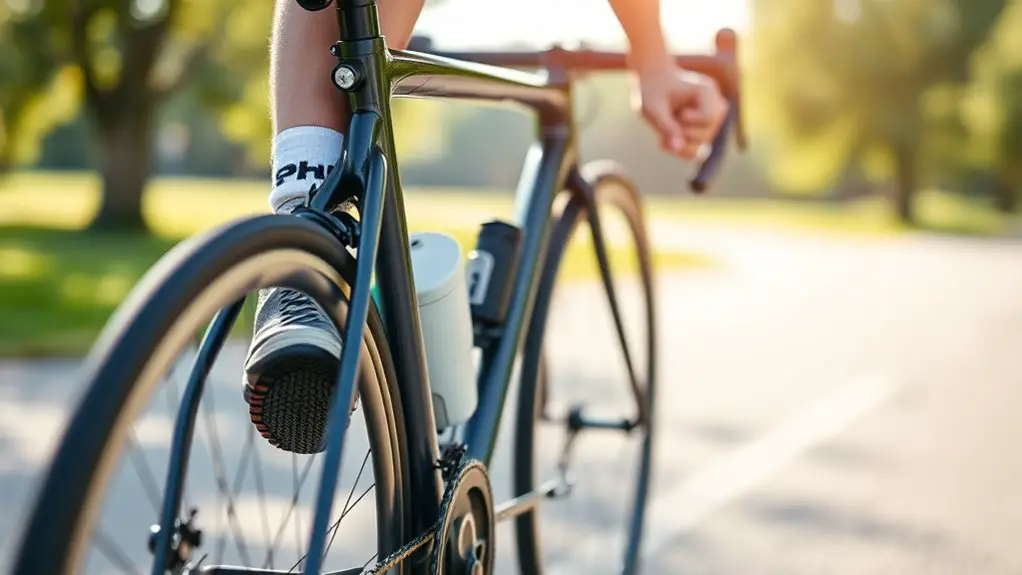Athletes take ice baths to speed up recovery, minimize muscle soreness, and build mental resilience after intense workouts. The cold exposure helps reduce inflammation, flushes out metabolic waste, and enhances blood flow to the muscles, enabling quicker healing. Plus, the numbing effect offers pain relief, allowing athletes to push through discomfort. If you’re curious about the science behind these benefits and safe practices to follow, there’s more to explore.
The Science of Cold Exposure
As you immerse yourself in the world of ice baths, it’s essential to understand the science behind cold exposure. Cold adaptation is a fascinating process that allows your body to adjust to lower temperatures, enhancing resilience. By regularly exposing yourself to cold, you’ll activate thermoregulation techniques, which help your body maintain its core temperature effectively. This adaptation not only sharpens your physical performance but also boosts mental fortitude. Your body learns to manage stress more efficiently, promoting a sense of freedom and control over discomfort. As you embrace the chill, you’ll discover how these physiological shifts empower you, enabling you to push your limits and reveal your true potential. Additionally, cold therapy has been shown to trigger endorphin release, providing an exhilarating rush that can enhance your training experience. So, plunge in and experience the transformation firsthand!
Benefits of Ice Baths for Muscle Recovery
While ice baths might sound uncomfortable, their benefits for muscle recovery are significant. You’ll find that these chilly dips can effectively reduce muscle soreness after intense workouts. By incorporating ice baths into your recovery strategies, you’re giving your body a chance to bounce back faster, helping you feel more energized and ready for your next session. The cold water helps constrict blood vessels, which minimizes swelling and flushes out metabolic waste. This means less fatigue and tightness in your muscles. Plus, the invigorating shock can boost your mental toughness, making you more resilient in the long run. Embracing ice baths could be the game-changer you need to enhance your performance and enjoy the freedom of movement you crave. Additionally, prioritizing rest after ice baths is essential for overall recovery and optimal muscle health.
How Ice Baths Reduce Inflammation
When you expose your body to cold through ice baths, it triggers a range of benefits that help reduce inflammation. This cold exposure not only constricts blood vessels but also enhances blood flow once you warm up, aiding in muscle recovery. As a result, you’ll notice quicker relief from soreness and improved overall performance.
Cold Exposure Benefits
Although many athletes swear by the benefits of ice baths, the science behind how cold exposure reduces inflammation is equally compelling. When you immerse yourself in ice-cold water, your body undergoes several changes that promote recovery. Here are some key benefits of cold exposure:
- Reduced swelling: Cold temperatures constrict blood vessels, minimizing inflammation.
- Pain relief: The numbing effect reduces discomfort in sore muscles.
- Faster recovery: Incorporating ice baths into your adaptation strategies can speed up healing.
- Mental resilience: Embracing cold exposure can strengthen your mind, enhancing focus and determination.
Blood Flow Regulation
As you immerse yourself in an ice bath, your body responds by constricting blood vessels, which plays an essential role in reducing inflammation. This process helps regulate blood flow and supports temperature regulation, allowing your muscles to recover while minimizing soreness.
| Blood Flow Response | Temperature Regulation |
|---|---|
| Constriction | Decreased Heat |
| Reduced Swelling | Balanced Core Temp |
| Enhanced Recovery | Improved Comfort |
| Quicker Adaptation | Sustained Relief |
Muscle Recovery Acceleration
While many athletes swear by ice baths for recovery, the science behind them reveals how effective they are at reducing inflammation. When you immerse yourself in cold water, your body responds by constricting blood vessels, which reduces swelling and alleviates muscle soreness. This makes ice baths a popular recovery technique for those looking to bounce back faster.
Consider the benefits:
- Decreased muscle soreness after intense workouts
- Enhanced recovery from injuries
- Improved range of motion
- Reduction of inflammation markers
The Role of Ice Baths in Preventing Injury
When you take ice baths, you’re not just soothing soreness; you’re actively reducing muscle inflammation, which can help prevent injuries. By enhancing your recovery time, these baths allow your body to bounce back faster between workouts. This means you’re less likely to face overuse injuries, keeping you in the game longer. Additionally, the cold exposure can boost blood flow and recovery, facilitating the delivery of essential nutrients to your muscles.
Reducing Muscle Inflammation
Ice baths have become a go-to recovery method for athletes aiming to reduce muscle inflammation and prevent injuries. When you immerse yourself in cold water, you’re not just braving the chill; you’re actively working to combat muscle soreness and promote inflammation reduction.
Here are some key benefits of ice baths:
- Decreases swelling: Cold temperatures constrict blood vessels, reducing inflammation.
- Eases muscle soreness: The numbing effect helps alleviate pain after intense workouts.
- Boosts recovery: Short-term exposure can enhance your body’s natural healing process.
- Improves circulation: The subsequent warming effect increases blood flow, promoting nutrient delivery.
Incorporating ice baths into your routine can empower you to train harder and recover faster, giving you the freedom to push your limits.
Enhancing Recovery Time
After addressing muscle inflammation, it’s important to contemplate how ice baths also play a vital role in enhancing recovery time and preventing injuries. When you immerse yourself in that icy water, you’re not just cooling off; you’re engaging in an essential post exercise ritual. These baths promote active recovery, allowing your body to bounce back faster and stronger. By constricting blood vessels, ice baths help reduce swelling and flush out metabolic waste, paving the way for improved circulation once you warm up again. This process can greatly lower your risk of injury, ensuring you stay in the game. So, if freedom in your athletic pursuits is what you crave, integrating ice baths into your routine may be the key to revealing your full potential.
Preventing Overuse Injuries
While many athletes focus on performance, neglecting recovery can lead to overuse injuries that sideline you for weeks. Ice baths play an essential role in overuse prevention and injury management by promoting muscle recovery and reducing inflammation. Incorporating this practice into your routine can help you stay on track and maintain your freedom to perform.
Consider these benefits of ice baths:
- Reduces muscle soreness after intense workouts
- Enhances blood flow, aiding recovery
- Decreases inflammation, minimizing injury risk
- Boosts mental resilience for future challenges
Psychological Effects of Cold Water Immersion
Although many athletes focus on the physical benefits of cold water immersion, the psychological effects can be just as significant. When you plunge into icy water, you’re not just numbing soreness; you’re also building mental resilience. That chill forces you to confront discomfort, teaching you how to push through tough moments in both sport and life. This experience can enhance your emotional recovery, helping you bounce back from setbacks with a stronger mindset. Plus, the rush of endorphins afterward leaves you feeling invigorated and ready to tackle challenges head-on. Additionally, incorporating mindfulness practices during the immersion can further enhance your focus and emotional regulation. So, if you’re seeking not just physical recovery but also a boost in your mental game, cold water immersion might just be the freedom you’re looking for.
Recommended Duration and Temperature for Ice Baths
When considering ice baths, you’ll want to pay attention to both temperature and soaking duration. The ideal temperature typically hovers around 50 to 59 degrees Fahrenheit, and soaking for about 10 to 15 minutes is usually recommended. Timing also matters—aim to get in the bath within 30 minutes post-workout for the best recovery benefits.
Ideal Ice Bath Temperature
To maximize recovery benefits, athletes should aim for an ice bath temperature between 50°F and 59°F (10°C to 15°C). This range guarantees you’re getting the ideal ice bath benefits without risking shock or discomfort. It’s all about achieving best cold exposure to reduce inflammation and speed up recovery.
Here are some key points to reflect on:
- Enhanced muscle repair: Helps reduce soreness and stiffness.
- Improved circulation: Stimulates blood flow post-exposure.
- Mental resilience: Teaches you to embrace discomfort.
- Reduced injury risk: Aids in recovery, keeping you in the game longer.
Optimal Soaking Duration
Finding the right soaking duration is essential for maximizing the benefits of ice baths. You’ll want to aim for ideal immersion times of 10 to 15 minutes, as this range allows your body to reap the rewards without risking any adverse effects. Using effective soaking techniques, like gradually easing into the ice bath, can make the experience more comfortable and effective. The water temperature should ideally be between 50 to 59 degrees Fahrenheit, ensuring you get the best results. Remember, it’s all about tuning into your body; if you start feeling too cold or uncomfortable, don’t hesitate to shorten your soak. Embrace the chill, and enjoy the recovery benefits that come with it!
Timing Post-Workout Importance
Timing your ice bath after a workout can greatly enhance recovery, especially if you take it within 30 minutes post-exercise. This essential recovery window allows your body to reap the benefits of cold therapy, reducing inflammation and muscle soreness. To maximize your ice bath experience, consider these factors:
- Temperature: Aim for 50-59°F (10-15°C) for ideal effectiveness.
- Duration: Soak for 10-15 minutes to balance benefits and discomfort.
- Frequency: Don’t overdo it; incorporate ice baths 1-3 times a week.
- Listen to Your Body: Adjust timing and temperature based on how you feel.
Alternatives to Ice Baths for Recovery
While ice baths have long been a popular recovery method for athletes, various alternatives can effectively aid in muscle recovery and reduce soreness. You might explore active recovery, like light jogging or cycling, to keep your blood flowing. Heat therapy, such as warm baths or heating pads, can soothe tight muscles. Compression garments help improve circulation, while stretching techniques enhance flexibility. Massage therapy is also great for relieving tension and promoting relaxation. Consider nutrition strategies, focusing on protein and hydration, to fuel your recovery. Hydrotherapy options, like contrast baths, can stimulate circulation. Finally, foam rolling is a fantastic way to release muscle tightness and improve mobility. Additionally, hydration is key for ensuring muscles are repaired and fatigue is minimized during recovery. These alternatives offer diverse paths to recover and feel your best!
Common Misconceptions About Ice Baths
Many athletes swear by ice baths for recovery, but there are several misconceptions that can cloud their effectiveness. Let’s explore some common athlete misconceptions that need myth debunking:
- Ice baths are only for professional athletes.
- They completely eliminate muscle soreness.
- Ice baths are harmful to your body.
- You should stay in for as long as possible.
Understanding these myths is vital. Many believe ice baths are a one-size-fits-all solution, but their benefits vary among individuals. In reality, while they can aid recovery, they’re not a magical fix. Cooling down properly after workouts, including techniques like stretching and hydration, can significantly enhance recovery as well. Recognizing the truth behind these misconceptions can empower you to make informed choices about your recovery routine, allowing you to embrace freedom in your athletic journey.
Testimonials From Professional Athletes
Numerous professional athletes have shared their experiences with ice baths, highlighting their role in enhancing recovery and performance. You’ll find personal stories from runners, football players, and swimmers who swear by this method. They describe the invigorating rush and how it helps reduce muscle soreness after intense training sessions. For many, it’s a ritual that’s become essential for maintaining peak performance. One athlete mentioned feeling rejuvenated after just a few minutes in the cold water, allowing them to push harder in their next workout. These athlete experiences emphasize the mental and physical benefits of ice baths, revealing that embracing this chilly practice can lead to greater freedom in your training and recovery journey. It’s about finding what works best for you.
Guidelines for Safe Ice Bath Practices
If you’re considering incorporating ice baths into your recovery routine, it’s important to follow some essential guidelines to guarantee safety and effectiveness. By taking these safety precautions, you can enjoy the benefits of ice baths while minimizing risks.
- Start with shorter durations (around 10-15 minutes) to gauge your tolerance.
- Verify the water temperature is between 50°F and 59°F for ideal recovery.
- Gradually acclimate your body by starting with cooler showers before diving into ice baths.
- Always have someone nearby, especially if you’re new to this recovery technique, to confirm your safety.
Frequently Asked Questions
How Often Should Athletes Take Ice Baths?
You should take ice baths after intense workouts or competitions, ideally 1-3 times a week. Frequency recommendations vary based on your training intensity and personal recovery strategies. Listen to your body—if you’re feeling sore or fatigued, an ice bath might help. Just remember, while they can be beneficial, finding what works best for you is key. Enjoy the freedom to experiment with your recovery routine and discover what feels right.
Can Ice Baths Be Harmful if Misused?
Yes, ice baths can pose risks if not used wisely. If you’re not careful, those chilly dips can lead to ice burns or even more serious recovery risks. It’s essential to listen to your body and limit exposure time. While they can soothe sore muscles, overdoing it might leave you feeling more frozen than refreshed. So, embrace the chill, but don’t let it chill your recovery journey! Balance is key.
What Should Athletes Wear During Ice Baths?
When you’re taking an ice bath, it’s best to wear compression gear or thermal wear. Compression gear helps enhance blood circulation, while thermal wear keeps you comfortable without restricting movement. You want to feel free during your recovery, so avoid anything too tight or heavy. Opt for lightweight materials that allow you to relax and focus on the benefits of the ice bath. Remember, comfort is key to your recovery process!
Are There Any Age Restrictions for Ice Baths?
There aren’t strict age restrictions for ice baths, but it’s crucial to follow age guidelines, especially for youth athletes. Younger athletes should consult with a coach or medical professional before diving in. While ice baths can be beneficial, kids’ bodies respond differently to cold therapy, so safety’s key. If you’re considering it for younger athletes, make sure it’s done under supervision and with proper understanding of their limits. Freedom in recovery is important, but so is safety!
Do Ice Baths Have Any Effect on Mental Toughness?
Ice baths can definitely boost your mental toughness. As the saying goes, “What doesn’t kill you makes you stronger.” By enduring the cold, you’re building mental resilience and embracing discomfort, which translates into psychological benefits in other areas of your life. You’ll learn to push through challenges, fostering a sense of freedom and control. So, if you’re seeking that extra edge, give ice baths a try; they might just toughen your mindset.




